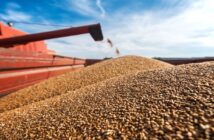As part of the organisation’s Centenary celebrations CEO and Director Dr Tina Barsby accompanied The Queen as she met staff in the Sophi Taylor Building Conference Centre and glasshouses at NIAB’s Park Farm field station on the outskirts of Cambridge.
The Queen viewed exhibits of variety evaluation in ornamentals and cereals, as part of the delivery of Plant Breeders’ Rights legislation, research work on monocot grafting and cowpeas, a showcase of ‘superwheat’ plants in the glasshouse, and a colourful visual display of NIAB’s history. She also spoke with some of NIAB’s longest serving members of staff, each with between 40 and 50 years’ service.
Dr Tina Barsby said, “This is the third time The Queen has visited NIAB as the organisation’s Patron, although the two previous visits were to our headquarters on Huntingdon Road in Cambridge on the occasion of NIAB’s 50th anniversary in 1969 and 75th in 1994. Both NIAB’s Cambridge sites are undergoing a period of redevelopment with a new headquarters building at Huntingdon Road opening in 2020. But we were delighted to host The Queen at Park Farm, featuring our two, recently opened, buildings with new analytical and research laboratories, growth rooms and offices.”
In the glasshouse plant breeder Dr Phil Howell showed NIAB’s award-winning resynthesised wheat research to The Queen. The programme recreates the original chance hybridisation from 10,000 years ago that led to the development of modern wheat, by crossing durum wheat (Triticum durum) with wild goatgrass (Aegilops tauschii). Dr Howell said, “The Queen showed great interest in the plants from each step of the process, including the resulting ‘superwheat’ which is delivering new high yielding, resilient genetic material used by researchers and commercial wheat breeding programmes across the world. She was very lovely to talk to and laughed at my comment that we were only showing her the best wheat plants from our research after ignoring the poorer ones.”
NIAB trials co-ordinator and archivist Tricia Cullimore welcomed The Queen with a display of images from her previous visits and from when King George V and Queen Mary opened NIAB’s original building in 1921. The Queen signed the visitor book, which she had signed in 1969 and 1994, as had her grandson, the Duke of Cambridge, when he visited NIAB in 2014. She was then presented with a wooden bowl, made from one of the original mulberry trees planted by her grandparents at Huntingdon Road in 1921. The bowl had been hand-carved by Kathleen Abbott, grand-daughter of NIAB’s founder Sir Lawrence Weaver.
The visit finished with The Queen enthusiastically planting a hornbeam tree outside the Sophi Taylor Building, accompanied by Sir Lawrence Weaver’s grandchildren Professor Lawrence Weaver and Mrs Abbott, NIAB Chairman Jim Godfrey and Dr Barsby, and cheered on by over 100 NIAB staff.




